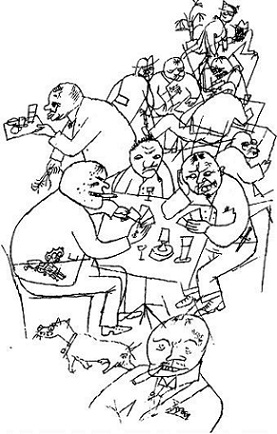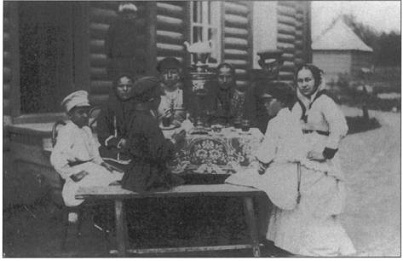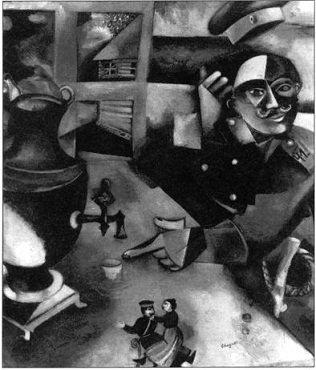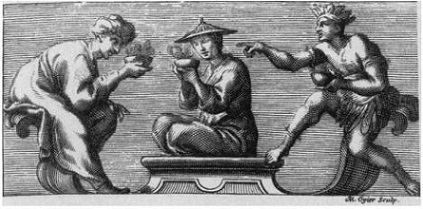The World of Caffeine (17 page)
Read The World of Caffeine Online
Authors: Bonnie K. Bealer Bennett Alan Weinberg

In Berlin, too, coffee caught on, and there, as across Germany,
Kaffeekrazchen,
mostly for women, became increasingly popular from the end of the eighteenth through the nineteenth centuries. Outdoor cafés and tents from which coffee and other refreshments were served also began to appear.
Tea, like coffee, arrived in Germany in the seventeenth century. It was at first available only from apothecaries, and appears on their price lists by 1657. At this time, it was also served in salons for the enjoyment of the upper classes. Its use spread slowly, except in coastal areas such as Ostfriesland where it was enthusiastically embraced; unlike coffee, tea never achieved great popularity nationwide.
Although chocolate arrived in Germany from Holland well after coffee and did not enjoy any aristocratic status from precedence, it nevertheless, at least during the eighteenth century, became associated with elegance and leisure. Schivelbusch asserts the theory that chocolate was a habit of the aristocratic and conservative ancien regime, while coffee was the choice of the rising middle class and the age of enterprise:

Coffee House (Kaffeehaus),
lithograph by German Expressionist artist Georg Grosz, 1917. The satirical scene depicts a Berlin café, epitomizing the brooding, sinister atmosphere dominating post-World War I Germany. (Berlinische Galerie, Landesmuseum Fur Moderne Kunst, Photographie und Architektur)
Goethe, who used art as a means to lift himself out of his middle class background into the aristocracy, and who as a member of a courtly society maintained a sense of aristocratic calm even in the midst of immense productivity, made a cult of chocolate, and avoided coffee. Balzac, who, despite his sentimental allegiance to the monarchy, lived and labored for the literary marketplace and for it alone, became one of the most excessive coffee-drinkers in history. Here
we see two fundamentally different working styles and means of stimulation—fundamentally different psychologies and physiologies.
13
This dichotomy seems more clever than correct, although Balzac certainly preferred coffee to tea, which he described as “an insipid and depressing beverage,” or to chocolate, for that matter. But Goethe too had enjoyed coffee—even, in his later judgment, excessively. Leipzig, which he visited at sixteen, though it had suffered the heavy indemnities imposed by the Prussians and was already in decline, was the first sizable city he ever saw, and, as a teenager, he wrote of its coffeehouses in
Memories of Youth.
Like many other Germans of his day, he also frequented the cafés of Italy during his Grand Tour, especially the Café Florian of Venice and the Café Greco of Rome. Because of this tourist traffic, the Café Florian, named for its first proprietor, who founded it in 1720, became one of the most celebrated on the Continent, the haunt of the Venetian aristocracy and a fast international set, as well as of artists and writers, whose ranks included Goldoni, Casanova, Rousseau, Byron, Alfred de Musset, and George Sand. The Café Greco, named for its Greek founder, Nicola della Maddelena, opened for business sometime before 1750. Its patrons included many famous Germans such as Schopenhauer, Mendelssohn, Liszt, Wagner, as well as Stendhal, Thackeray, Gogol, Mark Twain, Bizet, and Arturo Toscanini.
14
So, although it is true that, in his mature years, Goethe had reservations about coffee’s excessive use and berated his mistress for her lapse in their vow to abstain, it would be misleading to say that he “avoided coffee” altogether. And, as it turns out, Goethe was a kind of culinary pioneer, for, in the last decade of his life, at a time when “chocolate,” to most of his countrymen, meant a beverage, he discovered the solid confection while vacationing at an Austrian resort and made a present of a boxful of geological samples mixed with chocolate candies to Ulrike von Levetzow, a nineteenyear-old girl, attaching this couplet:
Enjoy this whenever it suits your mood,
Not as a drink but as a much-loved food!
15
The Russian love for tea was relatively late in coming. In 1567, Ivan Petroff and Boornash Yalysheff, two Russian travelers returning from China, brought home glowing reports of the tea plant but no samples. In 1618, a Chinese embassy carried some chests filled with tea on an overland journey lasting eighteen months as a gift to the Moscow court of Czar Alexis. This was the first tea to arrive in Russia, and the Russians were not very interested.
Vassily Starkoff, the Russian ambassador to the court of Mogul Kahn Altyn, tried tea in 1638 but did not care for it. He declined the offer of a gift of a sizable supply for Czar Michael Romanoff, founder of the Romanoff dynasty, expressing the judgment that it would prove of no value to his master.
16
As a result of his demurrer, Russia’s introduction to tea was delayed by half a century. After signing the Nerchinsk treaty with China in 1689, she began regularly to import brick tea by way of an overland caravan route through Manchuria and Mongolia, ending in the border town of Usk Kayakhta (Kiahta), which, by agreement, was to remain the sole site of commerce between the parties.
17
Russian caravans of several hundred camels, bearing furs for exchange, took a year to complete the round trip. Each camel returned bearing four chests, totaling about six hundred pounds of tea, traveling at the rate of only twentyfive miles a day. By 1700, more than six hundred camel loads of tea reached Russia every year, arriving at an exorbitant cost.
Czarina Elizabeth Petrovna (1709–61) established a regular imperial shipment in 1735 with the intention of increasing the supply of tea and bringing the price down. It was also during her reign that the samovar, a metal container with a pipe up the center to keep the water heated by the fire below, became a fixture in nearly every Russian household.
18
The Russians became habitual imbibers of very strong tea, which they palliated by sipping it through a lump of sugar clenched between their teeth. By the time of the death of Catherine the Great (1729–96), the six hundred camel loads had risen to six thousand, bringing the total importation to more than three million pounds and the price within reach of the average person. Caravan transport reached its height around 1860 and continued until after 1880, when the first leg of the TransSiberian Railway was opened. The final camel caravan transplanting tea from Peking to Russia arrived in 1900. After the completion of the rail line, what had been a sixteen-month journey could be completed in seven weeks. Subsequently, tea transport was made by train through the port of Vladivostok.
19
Russia also began importing tea through the port of Odessa from the Levant in the middle of the nineteenth century, a source that increased in significance after the 1890s. At the same time, the Russians also began importing teas from London. So-called Russian caravan tea, sold by various companies today, still tries to evoke the allure and mystery of these lost days but has no legitimate claim to the epithet, nor any resemblance to the high-quality brick teas of the original.
Today Russia is the largest tea-consuming nation in Europe. Her tea, usually drunk with lemon and sugar, is brewed very strong, and boiling water is often added to the cup to dilute it. The Russians supplement their traditional single large afternoon meal with cups of tea served throughout the day. The samovar promotes the custom because it keeps water near the boil, the perfect temperature for brewing tea.

Russian family from rural Siberia drinking tea around a copper samovar, an appurtenance indicating genteel status. The photograph was discovered in 1898 by the expedition of Harrison and Hiller. The reigning czar, Nicholas II, banned the manufacture and sale of vodka and encouraged use of the temperance beverage tea. “
Khlebosolstvo
—literally translated ‘bread and salt’ but in practice the Russian word for ‘hospitality’—centered on the great samovar which every household owned. This uniquely Russian device for keeping tea water always at the boil ensured visitors a welcome all day long. It consisted of a charcoal-burning base, a central chimney surrounded by an urn of water, and a top rack for holding a pot in which the infusion steeped.” (Quotation from Hale,
The Horizon Cookbook: An Illustrated History of
Eating and Drinking Through the Ages.
) (University of Pennsylvania Museum, Philadelphia, negative #s4–142239)
Caffeinated beverages were little used in any Scandinavian country before the turn of the eighteenth century. However, to judge from the royal edict promulgated against coffee and tea in Sweden in 1746, which inveighed against “the misuse and excesses of tea and coffee drinking,” their enjoyment had become general within less than fifty years. A heavy tax was levied on the users of the temperance drinks, and the failure of coffee and tea drinkers to confess themselves and pay the tax resulted in a heavy fine and “confiscation of cups and dishes,” seizure of the paraphernalia supporting the use of these psychoactive intoxicants.
Later that year any use of coffee was made illegal in Sweden. As alcohol prohibition in the United States was to do in the 1920s, the Swedish coffee prohibition engendered a flourishing bootlegging trade. Penalties against coffee drinking were made even stricter in 1766, but the flow of beans into Sweden continued.
King Gustav III (1746–92), determined to prove that coffee was a poison, ordered a convicted murderer to drink coffee every day until he died. In an attempt to do things scientifically, he ordered another murderer to drink tea daily, as a control, and appointed two doctors to oversee the experiment and report on which prisoner died first. Unfortunately, both doctors died and Gustav III was murdered before either prisoner succumbed. The two prisoners enjoyed, or at least endured, a long life until the tea drinker finally succumbed first at the age of eighty-three.
The outcome of this royal experiment had little effect on social policy. After switching from prohibition to a program of high taxation, Sweden’s regent again attempted to reimpose a coffee ban in 1794. This effort was renewed, without success, again and again until the early 1820s, after which Sweden’s government finally acceded to the will of her people. Ever since, Sweden’s per capita coffee consumption, and, correspondingly, her per capita caffeine consumption, has been among the highest in the world.

The Soldier Drinks,
an oil painting by Russian artist Marc Chagall, 1911–12, in which the samovar shares equal prominence with the titular subject of the painting. Perhaps the soldier is tipping his cap to his favorite things: his lover, his hometown, and, of course, his tea. (Solomon R. Guggenheim Museum)
judgements of history
Medical Men Debate Caffeine
We advise tea for the whole nation and for every nation. We advise men and women to drink tea daily; hour by hour if possible; beginning with ten cups a day, and increasing the dose to the utmost quantity that the stomach can contain and the kidneys eliminate.
—Dr. Cornelius Buntekuh, Medizinischen Elementarlehre, Dutch physician in the pay of the Dutch East India Company, c. 1680
Caffeine itself was not known until Goethe exhorted Runge to determine the chemical constituents of coffee beans and was not isolated from tea or cacao until some years later. However, the content of the spirited, often vituperative medical debates attending the introduction of coffee, tea, and chocolate proves that the medical men of the seventeenth and eighteenth centuries saw in these drinks a common, if unidentified, agency and that many of what we would today call the pharmacologic and psychoactive properties of caffeine were well recognized long before the drug itself was known. As a result, coffee, tea, and chocolate were frequently addressed together as medicinal products in early European texts. A famous example, widely translated in Europe, was Sylvestre Dufour’s
Traitez Nouveaux & curieux Du Café, Du Thé et Du
Chocolate, Ouvrage également necessaire aux Medecins, & tous ceux qui aiment leur santé
(1685), which means
New and
Curious Qualities of Coffee, Tea and Chocolate, a Work Equally Necessary for Doctors, & for All Who Value Their Health.
As the title illustrates, at the time of Dufour’s book, all three caffeinated drinks were still considered drugs, and their distribution in most countries was limited to apothecaries and physicians.
1
As all three caffeinated drinks became available to the lay public and became popular throughout most of the Western world, their ubiquity only served to fuel the ongoing medical controversies over the hazards of casual or indiscriminate consumption and stir new inquiries into their effects on the human body.
Some skilled in the medical lore of the seventeenth century devoted their time and talents to praising the caffeinated drinks for their ability to quicken the circulation, dispel inebriation and promote sobriety, increase alertness and creativity, cure gout, scurvy, and dropsy, relieve headaches and kidney stones, improve appetite and digestion, purify the blood, stimulate the wit, and prolong life. Others applied themselves to blaming these drinks for desiccating body and brain and inducing headaches, emaciation, impotence, and premature death. However, medical debates have rarely been conducted in isolation, free from the influences of political, economic, social, or religious forces, and the historical controversies over the merits of caffeinated beverages have been no exception. Important commercial interests were at stake in these disputes. At the same time that the Dutch East India Company tea merchants were underwriting Buntekuh, the physician who was perhaps Europe’s biggest promoter of caffeine, the French wine merchants were sponsoring his counterparts in their anticaffeine campaign.

Printer’s ornamental engraving from Dufour’s
Traitez Nouveux & curieux Du Café, Du The et Du Chocolate.
This engraving, appearing at the top of each chapter in Dufour’s famous 1685 work, is one of many contemporary depictions of men of three exotic nations and the caffeinated beverages indigenous to their homelands: The Turk with his coffee, the Chinese with his cup of tea, and the Aztec with a goblet of chocolate. (The Library Company of Philadelphia)
The Muslims not only gave to Europe the secret of drinking coffee and the institution of the coffeehouse; their sophisticated culture and science provided the basis for the medical controversies attending coffee’s introduction and proliferation in Europe as well. Medieval medical learning in the Muslim world was founded on the ancient humoral theory of Hippocrates as elaborated by Galen, and by the time coffee, tea, and chocolate arrived in and spread throughout Europe in the seventeenth century, medical thinking in the Western world, under the influence of Islamic learning, was defined by the humoral theory as well. Galen, a Greek physician who lived in Rome in the second century, posited four personal types: the melancholic, choleric, phlegmatic, and the sanguine, each corresponding with the predominance of one of the four humoral fluids and its associated properties. Food, drinks, and medicines were all considered by humoral theorists to possess one or more of these properties in one degree or another. Where a given property is present in the first degree, we have a food. Where present in the second degree, we have a food or a medicine. Where present in the third degree, we have a medicine only. Where present in the fourth degree, we have a poison.
The Humoral Scheme
| Humor | Temperament | Properties * |
| Black Bile | Melancholic | Dry-Cold |
| Yellow Bile | Bilious | Dry-Hot |
| Phlegm | Phlegmatic | Moist-Cold |
| Blood | Sanguine | Moist-Hot |
*Present in the first, second, third, or fourth degrees
Medical men, who worried over the actions of caffeinated drinks as drugs, and laymen, who accepted them as fortifying comestibles, agreed that the beverages, whether used as medicaments or refreshments, were effective antidotes to drunkenness and could induce and promote sobriety. Walter Rumsey (1584–1660), a Welsh judge who had been a student of both Francis Bacon and William Harvey, observed in a book chapter entitled “Experiments of Cophee” that the drink had the “power to cure drunkards.” Remnants of this theory survive today in the prevalent but erroneous belief that a cup of strong coffee can make you sober.
2
Nevertheless, people who drink coffee or tea throughout the day are more likely to be sober and efficient than those who drink beer. From Rumsey’s time onward, the energizing and sobering effects of the caffeinated beverages were emphatically contrasted with the laziness and impairment attending consumption of other available drinks—almost all of which were alcoholic because the drinking water was generally unsafe. Because of the pervasiveness of alcoholic drinks in the lives of medieval and early modern Europeans, the institution of chronic sobriety constituted a radical change of life. Beer, for example, in addition to being consumed, as it is today, at celebrations and holidays, of which there were many, or simply as a recreational intoxicant, was also a primary a source of nourishment, second in importance in the average diet only to bread, and its consumption was nothing less than unremitting. Johann Breschneider (
Lat.
Johann Placotomus, 1514–76), German physician and educator, wrote of beer in 1551, “Some subsist more upon this drink than they do on food People of both sexes and every age, the hale and the infirm alike require it.”
3
Schivelbusch asserts that a typical English family in the seventeenth century averaged three quarts of beer per person, including children, every day, and that brewing beer was part of a housewife’s usual duties. One of the reasons consumption was so high was that breakfast generally consisted of beer soup. If you are interested in trying a bowl, here is a recipe that survived in rural Germany at the end of the eighteenth century:
Heat the beer in a saucepan; in a separate small pot beat a couple of eggs. Add a chunk of butter to the hot beer. Stir in some cold beer to cool it, then pour over the eggs. Add a bit of salt, and finally mix all the ingredients together, whisking it well to keep it from curdling. Finally, cut up a roll, white bread, or other good bread, and pour the soup over it. You may also sweeten to taste with sugar.
4
When each day began with a dish like this and when there were frequent drinking contests, in the course of which competitors fell one by one into an unconscious stupor, until a lone victor, like Socrates in the
Symposium,
rose and went home in singular awareness of his heady triumph, a nearly unmitigated state of alcoholic impairment was endemic.
Eventually a new attitude toward alcohol, arising with and perhaps in part as a consequence of the beginnings of modern industrial society, began to predominate in Europe, an attitude that had less patience for drinking bouts or alcoholism as a way of life. Considered in the context of pandemic inebriation that plagued Europe before caffeine’s arrival, some of the more effusive claims made on behalf of the health benefits of the temperance beverages seem more reasonable; after all, simply curtailing alcohol consumption would have made millions feel better and work better from morning to evening.
Old ways die hard, and the ascent of the three new temperance beverages and the decline of traditional alcoholic drinks sometimes occasioned complaint. Elizabeth Charlotte (1652–1722), often called Liselotte von der Pfalz, a German princess who, after her marriage to the duke of Orléans, was required to relocate to Paris, wrote frequently in her correspondence to criticize the new drinks available at the court of Versailles:
Tea makes me think of hay and dung, coffee of soot and lupine-seed, and chocolate is too sweet for me—it gives me a stomachache—I can’t stand any of them. How much I would prefer a good
Kalteschale
[a cold soup made with wine and fruit] or a good beer soup, that wouldn’t give me a stomachache.
5
To judge from her letters, all three, coffee, tea, and chocolate, could still be credibly referred to at the beginning of the eighteenth century as “dainties” and “foreign spices.” But the future belonged to the temperance beverages. Even in North America, the popularity of coffee was apparent by 1670, only six years after the British took over Dutch New Amsterdam, by which time coffee had replaced beer as New York’s favorite breakfast drink.
Carolus Linnæus, the great eighteenth-century Swedish botanist who brought the first viable tea plants to Europe, seemed to foresee the change from the alcoholic to the workaholic that caffeine heralded: “On this account [coffee] might be considered useful by those who set a higher worth upon saving
their time than on maintaining their lives and health,
and who are compelled to work into the night.” His comment demonstrates a lucid understanding of what we now consider the primary benefit of caffeine: imparting energy, increasing alertness, and forestalling sleep, and its primary application, in helping us to work when it is required we do so. He seems equally sensible of the personal danger that the use of stimulants, or overwork, may entail.
Jules Michelet (1798–1874), French historian, philosopher, and poet, writing of Europe in the seventeenth century and envisioning coffee as the elixir of mental clarity that saved Europe from the diabolical ruination of alcohol, vividly contrasts the old excesses of alcohol with the new sobriety of coffee:
6
Henceforth is the tavern dethroned, the monstrous tavern is dethroned which even half a century earlier had sentyouths wallowing twixt casks and wenches, is dethroned. Fewer liquor-drenched songs on the night air, fewer noblemen sprawled in the gutter.... Coffee, the sober drink, the mighty nourishment of the brain, which unlike other spirits, heightens purity and lucidity; coffee, which clears the clouds of the imagination and their gloomy weight; which illumines the reality of things suddenly with the flash of truth.
As we have observed, the first European to make written mention of the coffee plant and beverage was a physician. Leonhard Rauwolf (d. 1596), a distinguished German doctor, famous in his time for both medicine and botany, is remembered chiefly for the book
Travels in the Orient
(1582), in which he tells the story of a two-and-a-half-year trip to the East. Rauwolf had embarked from Marseilles in 1573 and traveled as far as Persia before returning home to Augsburg in 1576. In the chapter depicting the sights and habits of the ancient city Aleppo, there occurs the passage in which the use of
chaube,
as he calls coffee, is inaugurated to Western letters:
If you have a mind to eat something or to drink other liquors, there is commonly an open shop near it, where you sit down upon the ground or carpets and drink together. Among the rest they have a very good drink, by them called
Chaube
that is almost as black as ink, and very good in illness, chiefly that of the stomach; of this they drink in the morning early in open places before everybody, without any fear or regard, out of
China
cups, as hot as they can; they put it often to their lips but drink but little at a time, and let it go round as they sit.
In this same water they take a fruit called
Bunnu
which…have within them, two yellowish grains in two distinct cells, and besides, being they agree in their virtue, figure, looks, and name with the
Bunchum
of
Avicenna,
and
Bunca
of
Rasis ad Almans
[Rhazes] exactly; therefore I will take them to be the same, until I am better informed by the learned.
This liquor is very common among them, wherefore there are a great many of them that sell it, and others that sell the berries, everywhere in their
Batzars.
7